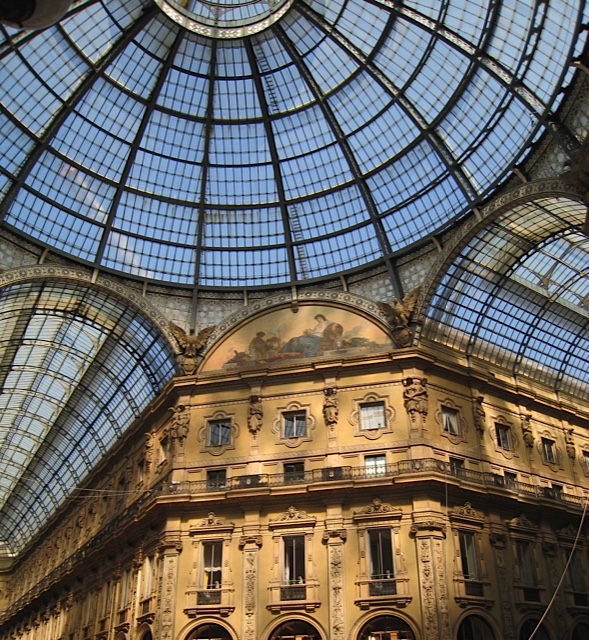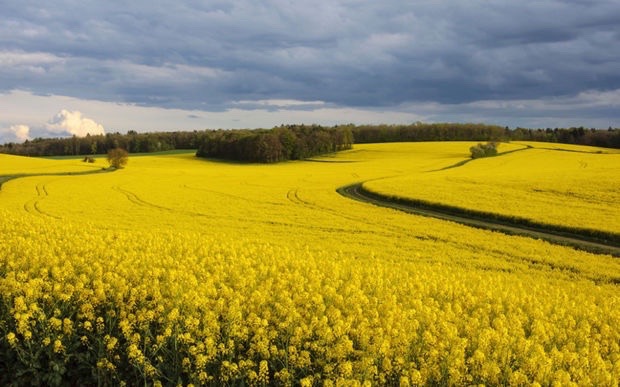
Our last day in Paris, we started the morning with a relaxing buffet breakfast, then took a taxi to the Gare de Lyon to catch the TGV, France’s high-speed train, to Dijon. At over two hundred miles per hour, the TGV is best described as fast. And four hundred and fifty daily connections throughout Europe make traveling by bullet train certainly more attractive than flying—not to mention more interesting.
As we neared Dijon, I was in awe of the acres of vibrant yellow fields that stretched to the horizon, their beauty even more striking contrasted against a backdrop of deep green hills. Naturally, I assumed the crop was mustard seed for Dijon mustard production. However, later in our trip a local gentleman informed me the crop was rapeseed for the manufacture of canola oil. Canola (Canada oil) was bred from rapeseed at the University of Manitoba in the early 1970s. He also told me that since 1950 mustard growing in the Burgundy region has declined with every passing year. Traditionally, mustard seed was grown in Burgundy by the same people who made charcoal. When charcoal production declined, so did mustard production. Today, 95 percent of the twenty-five thousand tons of seed used every year in French mustard production comes from Canada. As I was about to part company with him, he said, “Dijon mustard was first produced for the grand dukes of Burgundy, but the name refers only to the recipe and can be made anywhere.”
An hour and forty minutes later, our train pulled into the Dijon station. We collected our rental car and drove to Beaune, where we would stay for three nights while we explored the Burgundy wine region. We checked into the Hostellerie Le Cèdre, and with no plans for the afternoon except to sightsee, we dumped our bags in the room and set out. But first, at the urging of the hotel staff, we grabbed an umbrella from the stand near the front entrance.
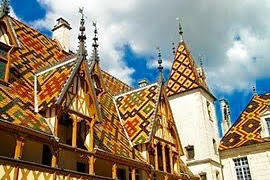 Our first destination was the Hospices de Beaune or Hôtel-Dieu de Beaune, a Gothic building with colorfully glazed roof tiles in an interlocking design of red, brown, yellow, and green. The building, now a museum, was once a hospital and refuge for the poor, who were cared for by an order of nuns.
Our first destination was the Hospices de Beaune or Hôtel-Dieu de Beaune, a Gothic building with colorfully glazed roof tiles in an interlocking design of red, brown, yellow, and green. The building, now a museum, was once a hospital and refuge for the poor, who were cared for by an order of nuns.
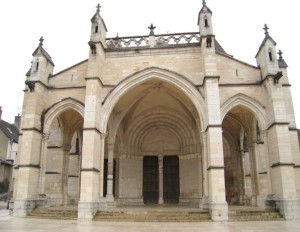 Next, we visited Collégiale Notre Dame, a church built in the twelfth century and constantly altered and embellished over the years to represent both Romanesque and Gothic architectural styles. Inside are rich tapestries depicting the life of the Virgin Mary. They were woven in Flanders in 1500. The front of the church is on rue d’Enfer (hell) and the back of the church on rue Paradis (heaven), if my French serves me correctly.
Next, we visited Collégiale Notre Dame, a church built in the twelfth century and constantly altered and embellished over the years to represent both Romanesque and Gothic architectural styles. Inside are rich tapestries depicting the life of the Virgin Mary. They were woven in Flanders in 1500. The front of the church is on rue d’Enfer (hell) and the back of the church on rue Paradis (heaven), if my French serves me correctly. 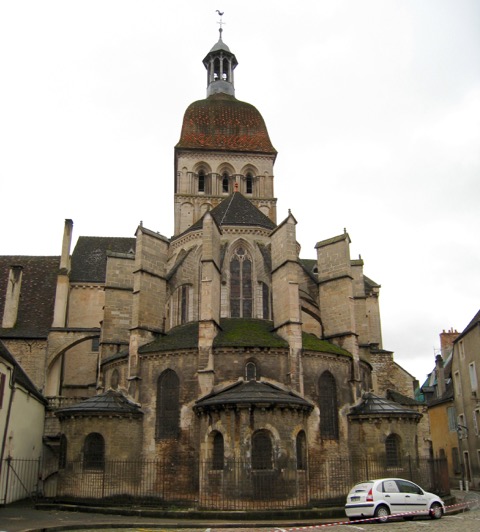 While beautiful from the front, the church is far more intriguing architecturally from the back.
While beautiful from the front, the church is far more intriguing architecturally from the back.
We didn’t take the train touristique, as we preferred to sightsee on foot, but a disembarking visitor said her hour ride was most enjoyable and well worth the seven euros.
As we drew near our hotel, the sky turned a dark gray, and threatening clouds gathered over Beaune. We ran for the entrance to Le Cèdre, reaching it just in time to avoid a dousing.
That night, we had dinner reservations at Le Bénaton. A bénaton is the traditional wicker basket used in nineteenth-century Burgundy to transport grapes from the fields during harvest. The photo shown is courtesy of St. Martin’s Gallery, which sells eighteenth- and nineteenth-century English, French, and Continental antiques.
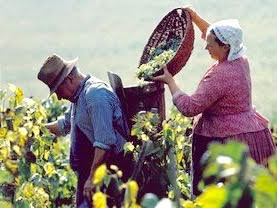 Le Bénaton is housed in a former home and is a small restaurant with limited seating. Our corner table was intimate and cozy, although at the hour we had booked, early by European standards, we were the only patrons. The interior was contemporary and decorated in warm golds and burgundy, with open stonework, bois de rose wood floors, and low light for a romantic environment.
Le Bénaton is housed in a former home and is a small restaurant with limited seating. Our corner table was intimate and cozy, although at the hour we had booked, early by European standards, we were the only patrons. The interior was contemporary and decorated in warm golds and burgundy, with open stonework, bois de rose wood floors, and low light for a romantic environment.
While we each sipped a glass of white wine and nibbled on olive bread, still warm from the oven, we perused the menu. We decided to order à la carte, as opposed to one of the set offerings: market, pleasures, flavors, and discovery. For starters, Dave ordered duck foie gras with smoked eel cassis. I ordered the scallops: grilled and in a truffle bouillon. For a main, I had wild turbot and butternut squash with a clementine reduction. And Dave ordered lamb with harissa, and fennel, carrots, and olives. For dessert, chocolate molten cake with a blackcurrant reduction, and gold mountain in a hot and cold caramel sauce. Spectacular!


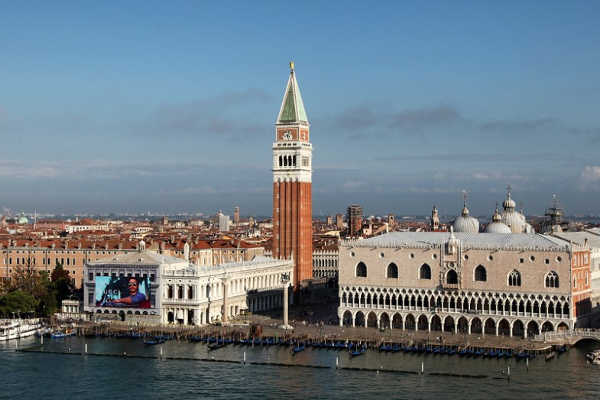
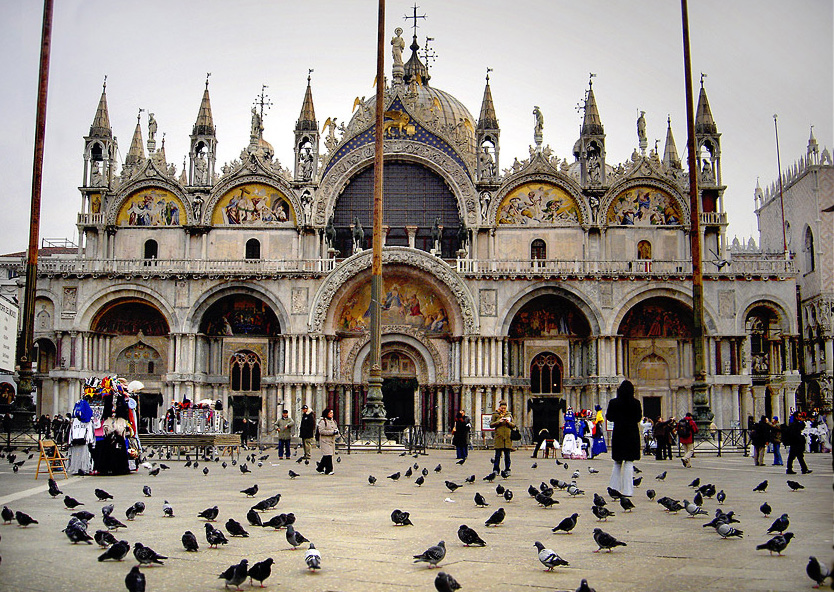 With my back to the basilica, I studied the architecture of the historic buildings. To my right were the old offices, circa sixteenth century, and the clock tower. To my left, the new offices, circa seventeenth century, and beyond them the square opened to the water. Behind me was the Correr Museum. Despite its size, the square felt protected, intimate, and definitely romantic.
With my back to the basilica, I studied the architecture of the historic buildings. To my right were the old offices, circa sixteenth century, and the clock tower. To my left, the new offices, circa seventeenth century, and beyond them the square opened to the water. Behind me was the Correr Museum. Despite its size, the square felt protected, intimate, and definitely romantic.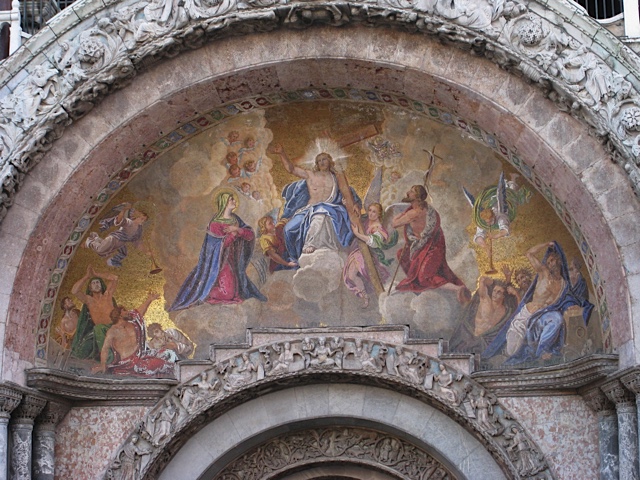 I gravitated toward the basilica, drawn by its Byzantine and Gothic architecture. Construction of the cathedral began in 829 with the intention of building a shrine for the body of St. Mark, believed to have been brought from Alexandria to Venice in the same year. Fire destroyed the church in 976, and it was rebuilt between 1043 and 1071. The exterior of the west facade is divided into three registers: lower, upper, and domes. The lower register has five arched portals that open into the narthex through bronze doors. The upper register has mosaics depicting the Life of Christ. The layout of the church is based on a Greek cross with four arms of equal length. Five domes cap the space—one over each arm and one over the center where the two arms cross.
I gravitated toward the basilica, drawn by its Byzantine and Gothic architecture. Construction of the cathedral began in 829 with the intention of building a shrine for the body of St. Mark, believed to have been brought from Alexandria to Venice in the same year. Fire destroyed the church in 976, and it was rebuilt between 1043 and 1071. The exterior of the west facade is divided into three registers: lower, upper, and domes. The lower register has five arched portals that open into the narthex through bronze doors. The upper register has mosaics depicting the Life of Christ. The layout of the church is based on a Greek cross with four arms of equal length. Five domes cap the space—one over each arm and one over the center where the two arms cross.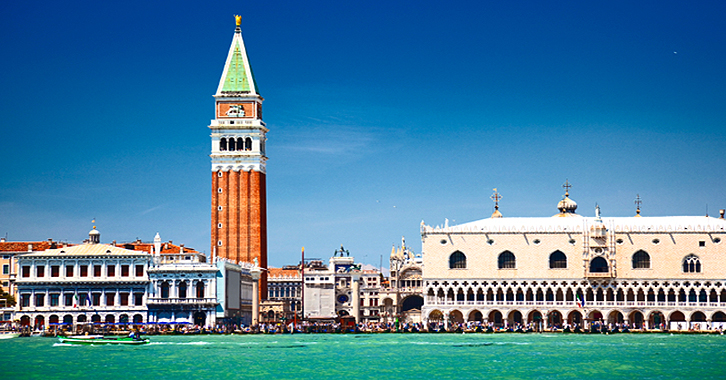 Outside the church, we crossed the square to the Campanile, the bell tower, which stands 323 feet high and has an elevator to the top for a spectacular view of Venice. We snapped a few shots of the city and some of the exterior of the tower, then walked on, hundreds of pigeons scattering in our wake. Relieved that we had avoided being dive-bombed by the birds, we skirted the outdoor cafés and left the piazza to explore the island, bypassing a visit to the Doge’s Palace. We were more interested in some other sites: the Rialto Bridge, the Grand Canal, Bridge of Sighs, and a few churches.
Outside the church, we crossed the square to the Campanile, the bell tower, which stands 323 feet high and has an elevator to the top for a spectacular view of Venice. We snapped a few shots of the city and some of the exterior of the tower, then walked on, hundreds of pigeons scattering in our wake. Relieved that we had avoided being dive-bombed by the birds, we skirted the outdoor cafés and left the piazza to explore the island, bypassing a visit to the Doge’s Palace. We were more interested in some other sites: the Rialto Bridge, the Grand Canal, Bridge of Sighs, and a few churches.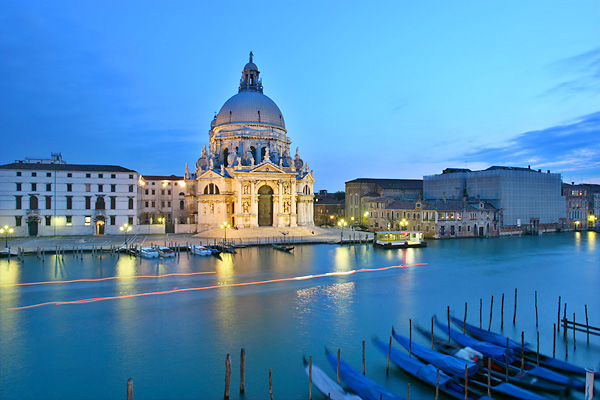 After two hours of sightseeing, and a tour of the Accademia Gallery, we made the short walk from the Accademia Bridge to Santa Maria della Salute. The domed baroque church stands on a narrow finger of land between the Grand Canal and the Bacino di San Marco. From what I have read, Doge Nicolò Contarini, before his death from the black plague, made a solemn vow to build a church to the Virgin Mary if she would free the city from the disease. He also promised that every year, on November 21st, he would lead a procession to the church. After his death, Doge Francesco Erizzo fulfilled Nicolò’s vow with the construction of Santa Maria della Salute. The plague killed almost one-third of the population of Venice.
After two hours of sightseeing, and a tour of the Accademia Gallery, we made the short walk from the Accademia Bridge to Santa Maria della Salute. The domed baroque church stands on a narrow finger of land between the Grand Canal and the Bacino di San Marco. From what I have read, Doge Nicolò Contarini, before his death from the black plague, made a solemn vow to build a church to the Virgin Mary if she would free the city from the disease. He also promised that every year, on November 21st, he would lead a procession to the church. After his death, Doge Francesco Erizzo fulfilled Nicolò’s vow with the construction of Santa Maria della Salute. The plague killed almost one-third of the population of Venice.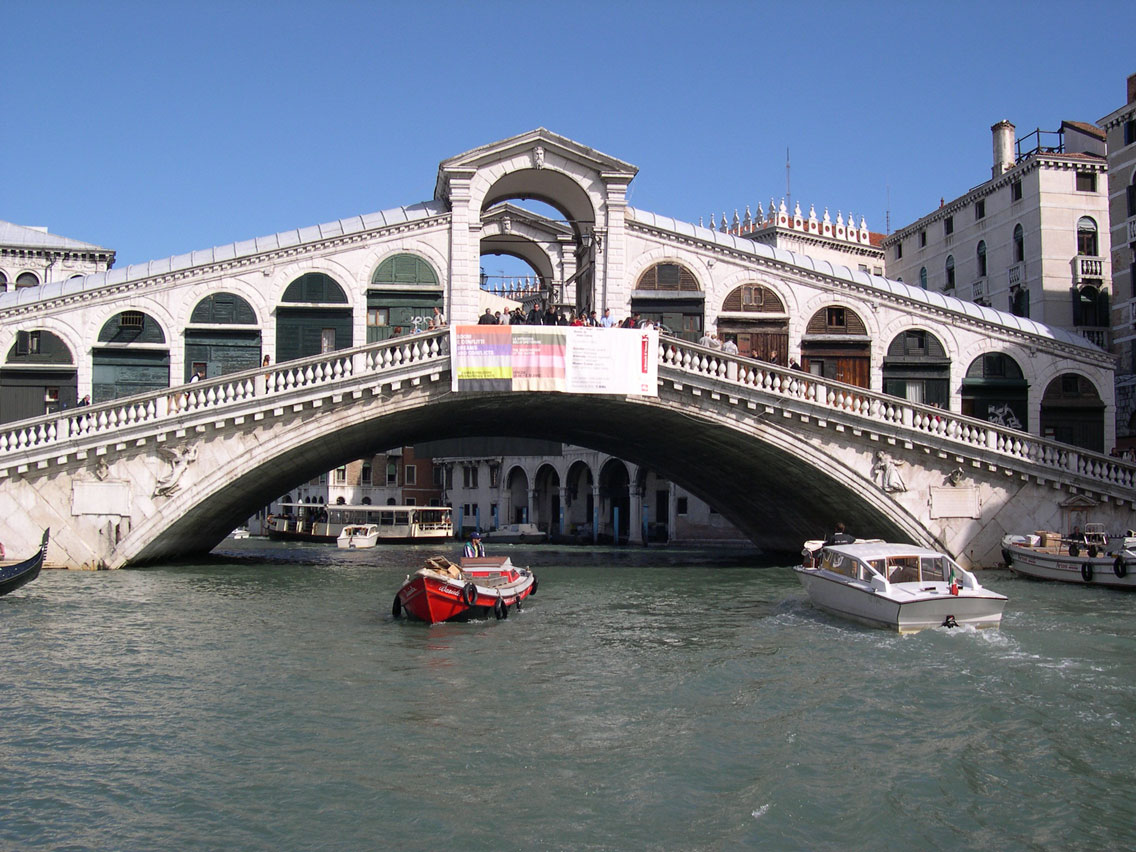 Late in the afternoon, we strolled across the Rialto Bridge to browse the shops and take in the scenery. We had been warned that some of the stores were not selling authentic Murano glass, but we had already made our purchases on the island and weren’t interested in buying more.
Late in the afternoon, we strolled across the Rialto Bridge to browse the shops and take in the scenery. We had been warned that some of the stores were not selling authentic Murano glass, but we had already made our purchases on the island and weren’t interested in buying more.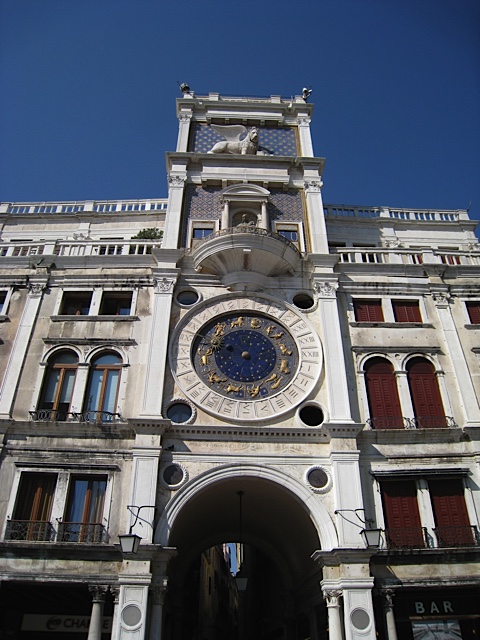 On our way back to our hotel, we stopped for a coffee at one of the cafés that line St. Mark’s Square, and to give our feet a short break before we made the jaunt to dinner. That night, we had reservations at Osteria Da Fiore.
On our way back to our hotel, we stopped for a coffee at one of the cafés that line St. Mark’s Square, and to give our feet a short break before we made the jaunt to dinner. That night, we had reservations at Osteria Da Fiore.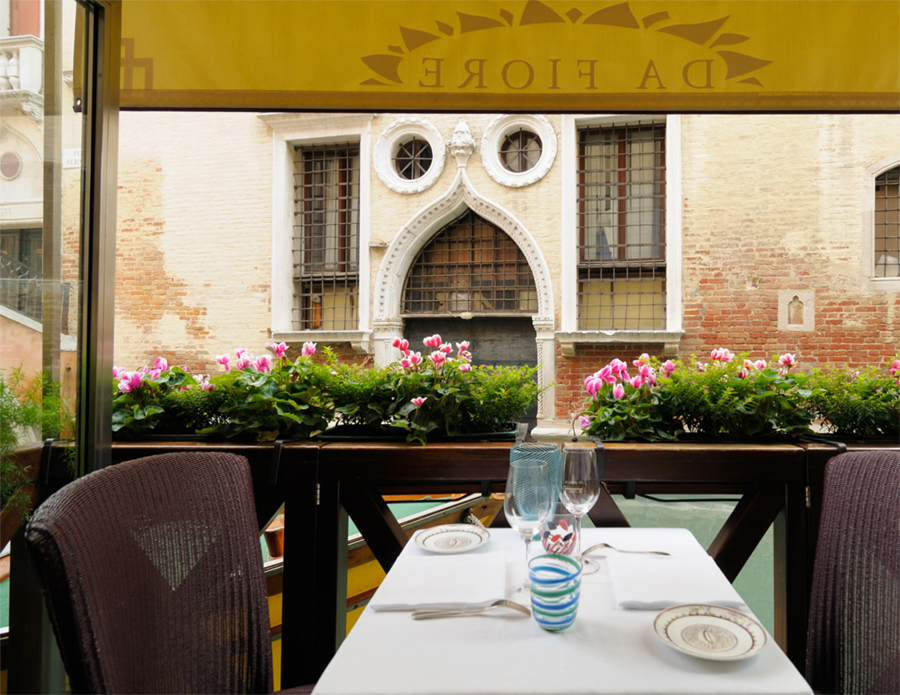 The warm evening was delightful, so we took our time walking through the maze of quaint narrow streets until we reached our restaurant. The waitstaff led us to a table for two on the only balcony in Da Fiore. It overlooked a quiet canal. The setting was very romantic, especially when the occasional gondola would cruise by and soft music would drift our way as the gondolier serenaded his riders . . . and us.
The warm evening was delightful, so we took our time walking through the maze of quaint narrow streets until we reached our restaurant. The waitstaff led us to a table for two on the only balcony in Da Fiore. It overlooked a quiet canal. The setting was very romantic, especially when the occasional gondola would cruise by and soft music would drift our way as the gondolier serenaded his riders . . . and us.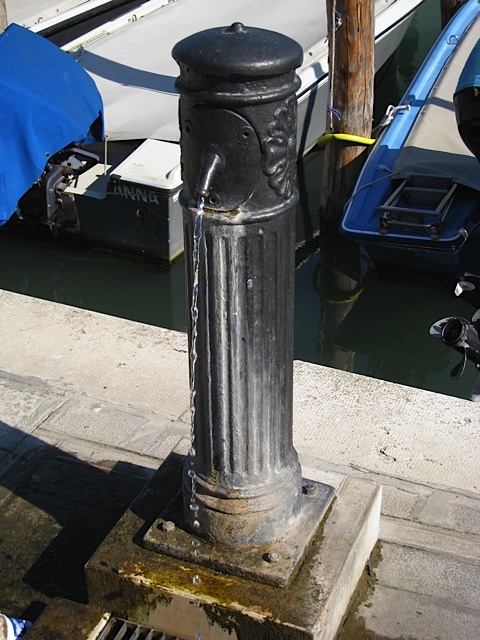 We passed on the six- or seven-course tasting menu and ordered à la carte, beginning with tiny shrimp tempura on creamy polenta followed by a seafood tower. For our mains, more fish. I had shrimp in seven spices, and Dave ordered wild bass steamed with apples. For dessert, I chose the chocolate cake and Dave an orange-apricot cream. Full, we sipped our wine and watched the next gondola as it slowly glided down the canal past our table, this gondolier too serenading us with a low, melodic tune.
We passed on the six- or seven-course tasting menu and ordered à la carte, beginning with tiny shrimp tempura on creamy polenta followed by a seafood tower. For our mains, more fish. I had shrimp in seven spices, and Dave ordered wild bass steamed with apples. For dessert, I chose the chocolate cake and Dave an orange-apricot cream. Full, we sipped our wine and watched the next gondola as it slowly glided down the canal past our table, this gondolier too serenading us with a low, melodic tune.